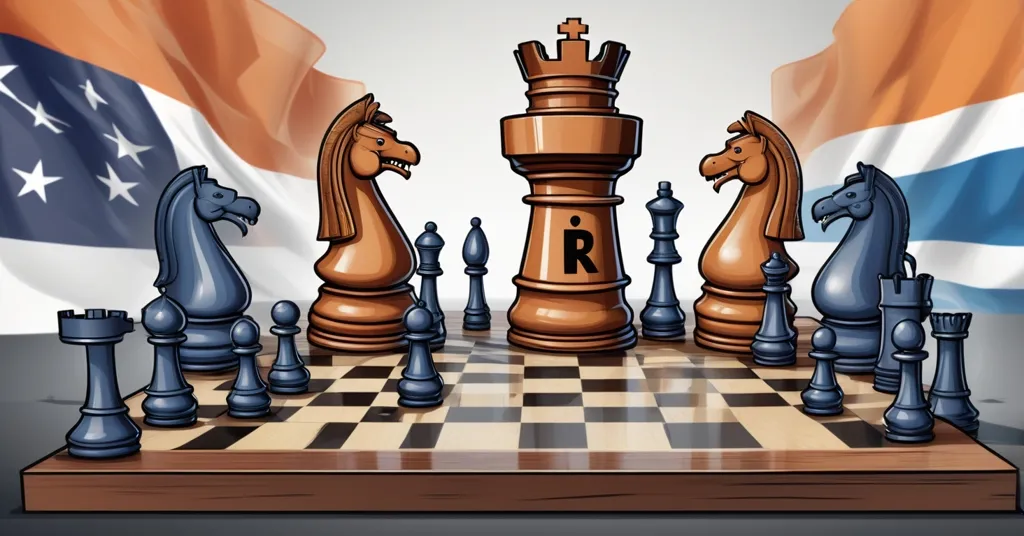Indian Minister Blasts US Over Russian Oil Trade Tariffs and Policy Flip

Indian Foreign Minister Slams US for Policy Reversal on Russian Oil Trade
India is caught in a geopolitical storm as the United States flips its stance on New Delhi’s purchase of Russian oil—a trade Washington once urged to stabilize global energy markets. Now, with a punitive 25% tariff hike on Indian goods set to raise duties to 50% by August 27, 2025, Indian Foreign Minister Subrahmanyam Jaishankar has fired back, calling out the US for its baffling inconsistency. Amidst accusations of India acting as a “laundromat for the Kremlin,” this clash raises deeper questions about energy security, economic warfare, and whether decentralized systems like Bitcoin and blockchain could offer a way out.
- US Policy Flip: From endorsing India’s Russian oil buys to imposing hefty tariffs as punishment.
- India’s Pushback: Jaishankar expresses confusion over the contradictory US logic.
- Crypto’s Potential: Could blockchain or Bitcoin bypass traditional trade sanctions?
India’s Energy Dilemma: A Necessary Pivot to Russian Oil
India, one of the world’s largest energy consumers, relies heavily on imported oil to power its economy and support its massive population. Before Russia’s invasion of Ukraine in February 2022, India imported virtually no oil from Moscow. But Western sanctions on Russia post-invasion created a unique opportunity: discounted crude oil that India couldn’t afford to ignore. By mid-2022, Russian oil accounted for a staggering 30-35% of India’s total imports, a move initially encouraged by the US to prevent global energy prices from spiraling out of control.
This wasn’t just opportunism—it was a matter of survival. With domestic energy demands soaring and traditional suppliers facing geopolitical constraints, India had to secure affordable resources wherever possible. Russian oil, priced well below market rates due to sanctions, became a lifeline. Yet, this strategic pivot has now landed India in hot water with the very nation that nudged them toward Moscow’s barrels: the United States. For a deeper look at the broader implications, consider the geopolitical impact of India-Russia energy ties.
Interestingly, India isn’t even the biggest buyer of Russian oil or Liquefied Natural Gas (LNG). That title belongs to China, with several European nations also ahead in the queue. Despite this, India finds itself singled out for criticism and economic penalties, while others seem to skate by with less scrutiny. It’s a curious double standard that hasn’t gone unnoticed in New Delhi.
US Policy Hypocrisy: From Encouragement to Punishment
The US policy reversal on India’s Russian oil trade is nothing short of a head-scratcher. For years, Washington pressed countries like India to engage with Russian energy markets to keep global oil prices in check, especially post-Ukraine invasion when supply chains were in chaos. Indian Foreign Minister Subrahmanyam Jaishankar made this point crystal clear during a recent joint press conference in Moscow with Russian Foreign Minister Sergey Lavrov, as highlighted in a recent statement slamming the US policy shift.
“We are a country where actually the Americans said for the last few years that we should do everything to stabilize the oil energy market, including buying oil from Russia,” Jaishankar remarked. “So, quite honestly, we are very perplexed by the logic of the [US] arguments.”
Fast forward to now, and the US has slapped a 25% tariff increase on Indian goods, bringing the total duty to a punishing 50%, effective August 27, 2025. The stated reason? India’s continued trade with Russia supposedly undermines efforts to isolate Moscow over the Ukraine conflict. White House Senior Advisor Peter Navarro has taken this criticism to another level with some particularly inflammatory language. For more context on Navarro’s stance, check this detailed report on his accusations.
“In India, 25% tariffs were put in place because they cheat us on trade. Then 25% because of the Russian oil… In many ways, the road to peace runs through New Delhi,” Navarro stated. He added, “Prior to Russia’s invasion of Ukraine in February 2022, India bought virtually no Russian oil… The argument now, when this percentage has gone up to 30-35%, that somehow they need Russian oil, is nonsense.”
Navarro’s accusation that India acts as a “laundromat for the Kremlin”—a derogatory jab implying India buys cheap Russian oil, refines it, and resells it at a premium to fund Russia’s war efforts—cuts deep. But let’s call a spade a spade: it’s downright hypocritical for the US to cry foul after explicitly encouraging this trade. And why is India the primary target when China and Europe purchase far larger volumes of Russian energy? If this is about ethics or geopolitics, the selective outrage smells like a calculated power play, not a principled stand.
Economic Fallout: Tariffs as a Sledgehammer
The looming 50% tariff on Indian goods isn’t a mere slap on the wrist—it’s a potential gut punch to India’s economy. Key export sectors like technology, pharmaceuticals, and textiles, which form the backbone of India-US trade, could face steep cost increases and reduced competitiveness in American markets. This isn’t just about numbers; it’s about livelihoods, growth, and the already strained diplomatic ties between two major democracies. Curious about public opinion on this? See this discussion on US tariffs impacting Indian trade.
For India, the tariffs signal a need to pivot. Strengthening trade with other partners or exploring alternative markets might soften the blow, but those options take time. Meanwhile, the immediate economic pressure could push New Delhi to double down on its energy ties with Russia, as confirmed by Russian First Deputy Prime Minister Denis Manturov, who noted ongoing oil shipments and interest in supplying LNG. India’s Minister of Petroleum and Natural Gas, Hardeep Singh Puri, has also underscored the robust bilateral cooperation with Moscow despite global turbulence. It’s a defiant stance, but a risky one if the US doubles down. For insights on how these tariffs affect India-Russia relations, explore this analysis of tariff impacts.
Could this economic warfare spark innovation in how nations trade? When centralized financial systems are weaponized through tariffs and sanctions, the allure of decentralized alternatives grows. That’s where the crypto angle kicks in, and it’s not as far-fetched as it might sound.
Decentralization as a Solution: Can Blockchain and Bitcoin Break the Mold?
Imagine a world where countries like India and Russia could settle oil trades without relying on traditional financial rails—systems like SWIFT that are often subject to US oversight and sanctions. This is where decentralized finance, or DeFi, comes into play. For the uninitiated, DeFi refers to financial systems built on blockchain technology, operating without intermediaries like banks. It’s the kind of disruptive innovation that Bitcoin champions have been preaching for years: borderless, censorship-resistant transactions. Learn more about this potential in this study on Bitcoin’s role in bypassing sanctions.
In theory, India could pay for Russian oil using Bitcoin or another cryptocurrency, bypassing dollar-dominated systems that enable tariffs and sanctions. Blockchain platforms could record these trades via smart contracts—self-executing agreements coded on networks like Ethereum—ensuring transparency without centralized control. Real-world experiments already exist; projects like IBM’s TradeLens and R3’s Corda have explored blockchain for supply chain and trade finance, proving the tech isn’t pure fantasy. RippleNet, another player, facilitates cross-border payments with digital assets, hinting at what’s possible for oil deals.
Let’s not get overly starry-eyed, though. Bitcoin’s price volatility makes it a shaky store of value for massive transactions like oil trades—imagine locking in a deal at $60,000 per BTC only to see it crash to $40,000 a week later. Regulatory hurdles are another beast; India’s own stance on crypto, with its 2022 tax regime slapping a 30% levy on gains, shows skepticism toward decentralized systems. And scaling blockchain to handle nation-state trade volumes? That’s a tech challenge we’re nowhere near solving. For Bitcoin maximalists like myself, there’s also the question of whether altcoins or other blockchains—often more centralized post-updates like Ethereum’s staking model—can truly offer the same resistance to control that BTC does. Still, the idea of decentralization as a middle finger to economic coercion is tantalizing.
This isn’t about shilling some utopian crypto fix—it’s about asking hard questions. If centralized powers can choke trade with a pen stroke, shouldn’t we be building systems they can’t touch? Bitcoin’s ethos of freedom and privacy aligns perfectly with this fight against overreach, even if the practical path forward is murky.
Geopolitical Chessboard: A Flicker of Leniency?
Amidst this tariff turmoil, a sliver of hope—or at least uncertainty—emerges from recent US-Russia diplomacy. President Donald Trump met with Russian President Vladimir Putin in Alaska on August 15, 2025, marking Putin’s first US visit in a decade. Trump hinted at a desire for peace in Ukraine, even floating ideas like territorial swaps as part of a broader deal. While no concrete policy shift on India’s tariffs has been announced, Trump’s gut feeling that “we have a shot” at resolution suggests the US might ease up on Russia’s trading partners. China, notably, has been spared similar tariffs for now, leaving room to wonder if India could dodge the bullet too. For updates on this meeting, refer to this report on Trump-Putin discussions.
Don’t hold your breath, though. Geopolitical games are rarely straightforward, and India remains a convenient scapegoat in the West’s broader push to isolate Moscow. This saga is a messy tangle of energy needs, moral posturing, and raw power dynamics, with no clean endgame in sight. For a comprehensive background on this crisis, check out this detailed overview of the US-India trade dispute.
Key Questions and Takeaways
- What sparked the US policy reversal on India’s Russian oil purchases?
The US shifted gears to isolate Russia economically over the Ukraine conflict, viewing India’s oil trade as indirect support for Moscow’s war efforts, despite previously encouraging the purchases to stabilize energy markets. - Why is India so frustrated with the US position?
India feels betrayed since the US explicitly urged buying Russian oil to prevent global price spikes, only to now impose punitive tariffs for following that advice. - How vital is Russian oil to India’s economy?
It’s critical, comprising 30-35% of India’s oil imports since 2022 compared to almost none before, driven by discounted prices amid sanctions on Russia. - What are the potential impacts of US tariffs on India?
A 50% total tariff could cripple Indian exports in tech, pharma, and textiles, strain US-India ties, and hinder economic growth unless alternative trade avenues emerge. - Could blockchain or Bitcoin offer a workaround for sanctions and tariffs?
Theoretically, decentralized systems like Bitcoin or blockchain could enable direct trade settlements outside US-controlled financial networks, though volatility, regulation, and scalability pose significant barriers. - Why might Bitcoin be better suited than altcoins for such trade solutions?
Bitcoin’s unparalleled decentralization and resistance to control make it a stronger candidate than many altcoins, which often carry centralization risks through governance or staking models like Ethereum’s.
This US-India spat over Russian oil is more than a trade dispute—it’s a stark reminder of how centralized power can weaponize economics. India’s balancing act between energy security and international pressure won’t resolve easily, and the US playing hardball while sparing bigger players like China reeks of hypocrisy. Yet, for those of us rooting for decentralization, it’s a clarion call. If tariffs and sanctions are the old guard’s tools, then Bitcoin and blockchain might just be the rebel’s blueprint for a freer system. Sure, the road from speculation to reality is littered with potholes, but isn’t that why we push for disruption in the first place? As this geopolitical drama unfolds, one thing is clear: the fight for financial sovereignty has never been more urgent.



